CHAPTER 159
Zipper Entrapment
(Penis or Chin)
Presentation
Usually a child has dressed too quickly and, possibly not wearing underpants, has accidentally pulled penile skin into his zipper. The skin becomes entrapped and crushed between the teeth and the actuator (slide) of the zipper, thereby painfully attaching the article of clothing to the body part involved (most often, the penis, or less often, the area beneath the chin) (Figure 159-1). There is generally little or no bleeding.
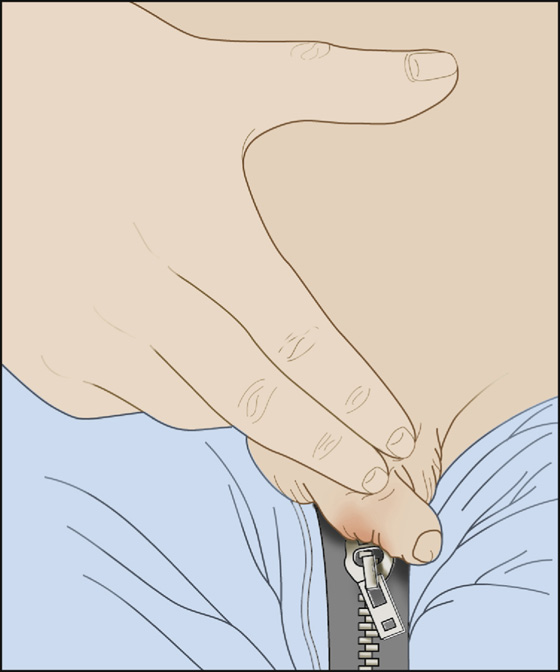
Figure 159-1 Penis caught in zipper.
What To Do:
 First, lubricate the entrapped skin and zipper with mineral oil. In a significant percentage of cases, the entrapped skin may be released with lubrication and gentle lateral traction. This obviates the need for painful local anesthesia, systemic analgesia, and more complicated interventions.
First, lubricate the entrapped skin and zipper with mineral oil. In a significant percentage of cases, the entrapped skin may be released with lubrication and gentle lateral traction. This obviates the need for painful local anesthesia, systemic analgesia, and more complicated interventions.
 If this is unsuccessful, consider systemic analgesics before local infiltration, which will be distressing and painful, especially in children. Intranasal fentanyl may be a good option. In some cases, procedural sedation may be necessary.
If this is unsuccessful, consider systemic analgesics before local infiltration, which will be distressing and painful, especially in children. Intranasal fentanyl may be a good option. In some cases, procedural sedation may be necessary.
 Paint the area with a small amount of povidone-iodine (Betadine), and infiltrate the skin with 1% buffered lidocaine (without epinephrine). As an alternative, perform a dorsal penile block. This will allow comfortable manipulation of the zipper and the article of clothing (Figure 159-2). A more time-consuming alternative that sometimes may be more acceptable to the patient is to use a eutectic mixture of lidocaine and prilocaine (EMLA) to provide dermal anesthesia through the intact skin. This may take 45 to 60 minutes to become effective and therefore should be applied as soon as the patient arrives.
Paint the area with a small amount of povidone-iodine (Betadine), and infiltrate the skin with 1% buffered lidocaine (without epinephrine). As an alternative, perform a dorsal penile block. This will allow comfortable manipulation of the zipper and the article of clothing (Figure 159-2). A more time-consuming alternative that sometimes may be more acceptable to the patient is to use a eutectic mixture of lidocaine and prilocaine (EMLA) to provide dermal anesthesia through the intact skin. This may take 45 to 60 minutes to become effective and therefore should be applied as soon as the patient arrives.
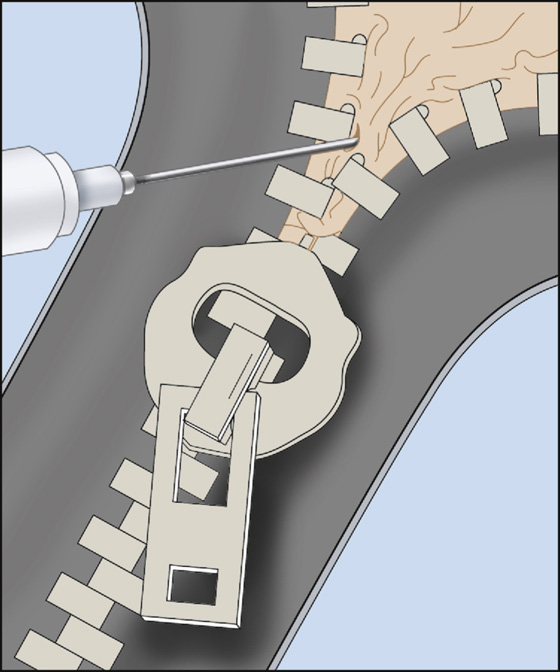
Figure 159-2 Injection of lidocaine.
 Cut the zipper away from the article of clothing. This will improve access/visualization and will reduce the pain associated with the weight of the clothing on the entrapped skin.
Cut the zipper away from the article of clothing. This will improve access/visualization and will reduce the pain associated with the weight of the clothing on the entrapped skin.
 The method of removal selected will depend on where in the zipper the skin is entrapped.
The method of removal selected will depend on where in the zipper the skin is entrapped.

 Between the teeth of the zipper: this technique may work without elaborate pain control strategies. Simply cut across the zipper above and below the area of entrapment. It may even be possible just to cut the closed zipper teeth below the actuator, permitting the unzipping of the zipper from the rear. Pull the teeth gently apart to release the skin (Figure 159-3).
Between the teeth of the zipper: this technique may work without elaborate pain control strategies. Simply cut across the zipper above and below the area of entrapment. It may even be possible just to cut the closed zipper teeth below the actuator, permitting the unzipping of the zipper from the rear. Pull the teeth gently apart to release the skin (Figure 159-3).
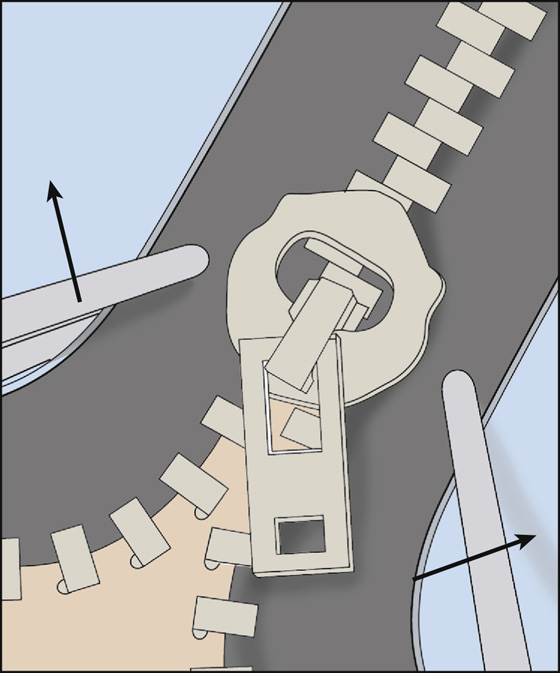
Figure 159-3 Opening zipper from rear.

 Within the slide (actuator): cut the median bar (which holds the anterior and posterior halves, or faceplates, of the actuator together) with a pair of metal snips, a bone cutter, or an orthopedic pin cutter (Figure 159-4, A). The patient is less likely to be frightened if this procedure is kept hidden from his view.
Within the slide (actuator): cut the median bar (which holds the anterior and posterior halves, or faceplates, of the actuator together) with a pair of metal snips, a bone cutter, or an orthopedic pin cutter (Figure 159-4, A). The patient is less likely to be frightened if this procedure is kept hidden from his view.
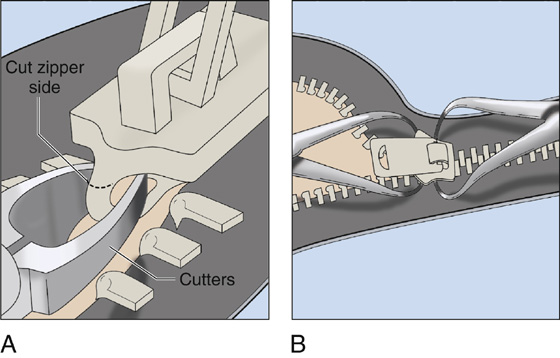
Figure 159-4 Cut zipper actuator bar with a metal snip bone cutter or an orthopedic pin cutter (A), or use two heavy-duty surgical towel clamps to break the actuator apart (B).
 If unable to break the two halves of the slide apart using a metal cutter, take two heavy-duty surgical towel clamps, and place their tongs into the side grooves at both ends of the slide. Grip one clamp firmly in each hand, and twist your wrists in opposite directions. This often will pop the two halves of the actuator apart, releasing the entrapped skin (Figure 159-4, B).
If unable to break the two halves of the slide apart using a metal cutter, take two heavy-duty surgical towel clamps, and place their tongs into the side grooves at both ends of the slide. Grip one clamp firmly in each hand, and twist your wrists in opposite directions. This often will pop the two halves of the actuator apart, releasing the entrapped skin (Figure 159-4, B).
 Alternatively, insert the head of a small slotted (flathead) screwdriver between the anterior and posterior faceplates of the slide, and rotate the head 90 degrees. This may increase the gap between the faceplates enough to facilitate release of the skin.
Alternatively, insert the head of a small slotted (flathead) screwdriver between the anterior and posterior faceplates of the slide, and rotate the head 90 degrees. This may increase the gap between the faceplates enough to facilitate release of the skin.
 After the zipper slide has been removed, pull the exposed zipper teeth apart, cleanse the crushed skin, and apply an ointment such as bacitracin (Figure 159-5).
After the zipper slide has been removed, pull the exposed zipper teeth apart, cleanse the crushed skin, and apply an ointment such as bacitracin (Figure 159-5).
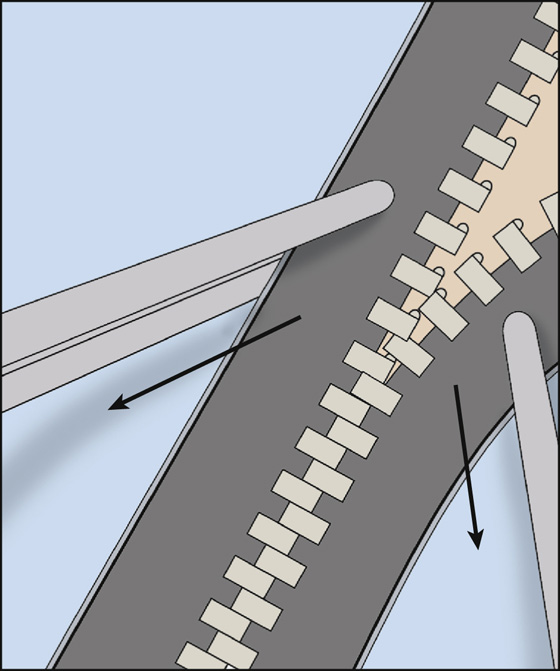
Figure 159-5 Pull exposed zipper teeth apart.
 Tetanus prophylaxis should be administered as needed (see Appendix H).
Tetanus prophylaxis should be administered as needed (see Appendix H).
 In the rare case when none of the described maneuvers is effective, consult a urologist. The urologist may elect to perform an elliptic incision, or emergency circumcision in the operating room.
In the rare case when none of the described maneuvers is effective, consult a urologist. The urologist may elect to perform an elliptic incision, or emergency circumcision in the operating room.
What Not To Do:
 Do not cut clothing if mineral oil releases the zipper.
Do not cut clothing if mineral oil releases the zipper.
 Do not fail to provide appropriate pain control.
Do not fail to provide appropriate pain control.
 Do not destroy the entire article of clothing by cutting into it. Only the zipper needs to be cut away, allowing repair of the clothing.
Do not destroy the entire article of clothing by cutting into it. Only the zipper needs to be cut away, allowing repair of the clothing.
 Do not excise an area of skin or perform a circumcision; it only creates unnecessary morbidity for the patient.
Do not excise an area of skin or perform a circumcision; it only creates unnecessary morbidity for the patient.

Full access? Get Clinical Tree


